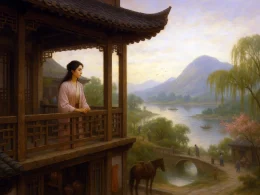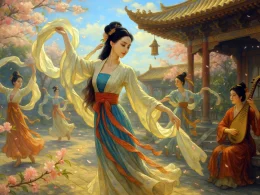Her zither pierces clouds with tones divine,
Where drowned princesses haunt the misty brine.
The River God dances with futile zeal,
While exiled Chu souls choke on grief too real.
Bitter strains out-cry metal and stone,
Pure notes rise where dark stars alone.
From Cangwu mounts drifts endless woe,
White blooms breathe scent through winds that blow.
Xiao's waves bear melodies away,
Dongting's gales weep through reed beds grey.
The song ends—no form in sight,
Just jade-green peaks in fading light.
Original Poem
「省试湘灵鼓瑟」
钱起
善鼓云和瑟,常闻帝子灵。
冯夷空自舞,楚客不堪听。
苦调凄金石,清音入杳冥。
苍梧来怨慕,白芷动芳馨。
流水传潇浦,悲风过洞庭。
曲终人不见,江上数峰青。
Interpretation
Composed in 751 for the imperial civil service examination, this regulated verse established Qian Qi's literary reputation and became the most celebrated examination poem of the Tang dynasty. Drawing from the Chuci tradition where Xiang River goddesses play zithers to mourn the legendary Emperor Shun, the poem transforms a mythological motif into profound meditation on art's transcendent power to connect human emotion with cosmic forces.
First Couplet: 善鼓云和瑟,常闻帝子灵。
Shàn gǔ yún hé sè, cháng wén dì zǐ líng.
She masters the Cloud-Harmony zither's strain—
This daughter of emperors, this spirit we name.
The opening establishes sacred musicality: the "Cloud-Harmony" instrument (云和瑟) bridges celestial and terrestrial realms, while "daughter of emperors" (帝子灵) elevates the goddess from folk deity to imperial mourner. The fusion of musical and royal imagery creates a hierophantic atmosphere befitting the examination's solemn context.
Second Couplet: 冯夷空自舞,楚客不堪听。
Féng yí kōng zì wǔ, chǔ kè bù kān tīng.
River god Feng Yi dances without heart—
Only exiled Chu souls understand the art.
This contrast reveals the poem's central thesis: true artistic appreciation requires shared suffering. The river god's hollow performance (空自舞) highlights how aesthetic depth demands existential resonance—embodied by the exiled "Chu souls" (楚客) whose displacement mirrors the goddess's eternal mourning.
Third Couplet: 苦调凄金石,清音入杳冥。
Kǔ diào qī jīn shí, qīng yīn rù yǎo míng.
Her bitter notes would soften metal and stone,
Clear tones piercing the underworld's unknown.
The zither's acoustic power achieves alchemical transformation (凄金石) and spiritual penetration (入杳冥). These parallel feats demonstrate art's dual capacity to alter material reality and traverse metaphysical boundaries—a Tang dynasty vision of artistic potency.
Fourth Couplet: 苍梧来怨慕,白芷动芳馨。
Cāng wú lái yuàn mù, bái zhǐ dòng fāng xīn.
From Cangwu comes Emperor Shun's answering cry,
While angelica herbs release scented sigh.
The poem's emotional geography expands: distant Cangwu mountain (苍梧), burial site of Emperor Shun, resonates with the music, completing the divine duet. The angelica (白芷), a Chuci symbol of virtue, responds synesthetically—fragrance becoming the vegetation's emotional language.
Fifth Couplet: 流水传潇浦,悲风过洞庭。
Liú shuǐ chuán xiāo pǔ, bēi fēng guò dòng tíng.
Currents carry melodies to Xiao's shore,
Sorrow-winds sweep Dongting's floor.
Hydraulic and atmospheric vectors disseminate the lament. The Xiang River's flow (流水) and Dongting Lake's winds (悲风) become cosmic conductors, transforming local grief into universal elegy through China's sacred waterscapes.
Final Couplet: 曲终人不见,江上数峰青。
Qǔ zhōng rén bú jiàn, jiāng shàng shù fēng qīng.
Music ends—no goddess in view,
Just emerald peaks over river blue.
The conclusion achieves sublime emptiness: the vanished goddess (人不见) leaves only enduring nature (数峰青) as witness. These "emerald peaks" become both geological fact and metaphysical permanence—art's consolation against human transience, perfectly suited to an examination poem aspiring to literary immortality.
Holistic Appreciation
The poem is meticulously structured and rich in emotion, blending the mythical essence of Chu Ci (楚辞) tradition with the Tang dynasty's distinctive poetic craftsmanship. Beginning with the Xiang River Goddess (湘灵) playing the se (瑟, a zither-like instrument), the poet unfolds a vivid imagination through auditory sensations, intertwining mythical figures and natural landscapes to merge sorrow with artistic beauty. The allusions are seamlessly integrated, the language elegant and refined, and the emotions restrained yet profound. The concluding couplet—"The music ends, no one in sight; / Only green peaks stand by the river"—transforms the intangible into the tangible and embeds emotion within scenery with remarkable economy. This closing, both cyclical and open-ended, has been hailed by later generations as "a stroke of divine brilliance."
Artistic Merits
As an examination poem bound by strict thematic constraints, this work adheres to its assigned topic without cliché, employing allusions deftly and crafting language that is mournful yet exquisite. Within these formal limitations, Qian Qi demonstrates extraordinary poetic vision and technical mastery, perfectly merging mythical imagery with personal sentiment—achieving what might be called "dancing in shackles." The poem emphasizes the harmony between sound and emotion, excelling in creating a profound aesthetic atmosphere through its artistic conception, embodying the lofty and ethereal style of Tang regulated verse (律诗).
Insights
This poem not only showcases Qian Qi's exceptional artistic talent but also teaches us that even within rigid thematic and formal constraints, one can produce deeply moving works through imaginative richness and emotional subtlety. The legend of the Xiang River Goddess playing the se lends the poem mystery and beauty, while the poet's evocation of the music and his atmospheric rendering breathe life into this tale of sorrow and splendor. It also allows us to appreciate the ultimate charm of literary creation: the fusion of scene and emotion (情景交融), and the resolution of feeling through landscape (以景结情).
About the Poet
Qian Qi (钱起, c. 722-780), a native of Huzhou, Zhejiang, was the foremost of the "Ten Talents of the Dali Era" in mid-Tang poetry. His poetic style, inheriting Wang Wei's legacy, excelled particularly in regulated verse (五律), characterized by its ethereal elegance. Yan Yu praised his work as "innovative in form," reflecting the Dali period's transition from the High Tang's naturalism to refined craftsmanship.












